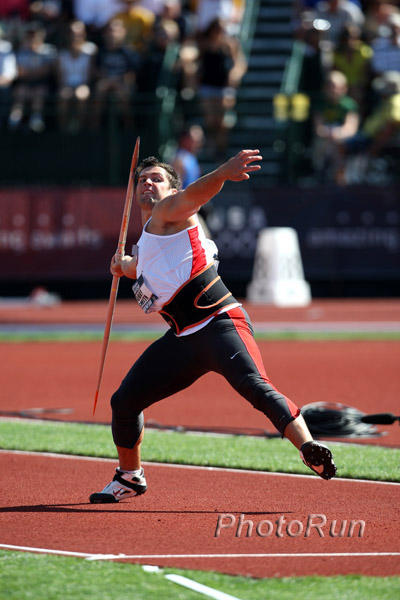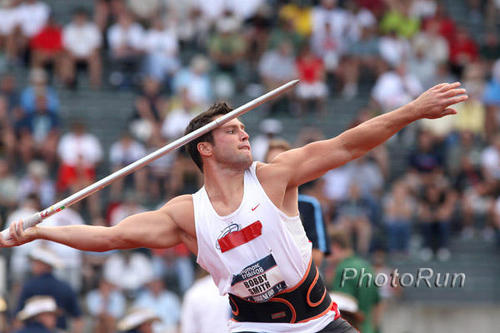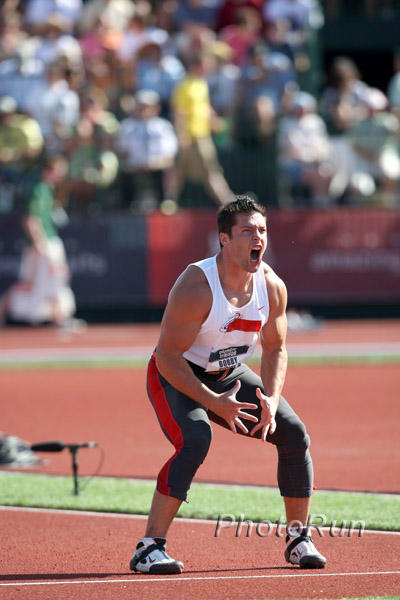Elliott Denman uses the experiences of Bobby Smith, the winner in the javelin in 2008 U.S. Olympic Trials, to support his argument on the standards at the U.S. Olympic Trials. The story is compelling.
 Bobby Smith, 2008 U.S. Olympic Trials, photo by PhotoRun.net
Bobby Smith, 2008 U.S. Olympic Trials, photo by PhotoRun.net
JUST ASK BOBBY SMITH,
THE TRIALS PROCESS
IS A ‘STANDARD’ TRIBULATION
By ELLIOTT DENMAN
Bobby Smith ranks as an all-time coulda-woulda-shoulda guy of American track and field.
Coulda been a 2008 USA Olympian.
Woulda gone to Beijing.
Shoulda been there if only the stats-keepers and the rules-makers and window-checkers of eight years back had written a degree of flexibility into all their decrees on this whole business of “standards.”
Then, four years out of New Jersey’s Monmouth University, where he’d been both a standout running back on Coach Kevin Callahan’s football team and sterling javelin thrower on Coach Joe Compagni’s track and field team, longshot Bobby Smith led the way in the 2008 USA Trials at Eugene’s Hayward Field with a pitch of 76.04 meters / 249-6.
It was the best throw of his life and he did it in the finals of the biggest meet of his life. Wow, did he ever “rise to the occasion.”
But all it got him were pats on the back and a few “well dones” and an unsettling trip – not to China – but back to Newark International Airport.
And recognition – to this day – as the poster boy for this often confusing and constant confluence of conflicting contentions.
It was those bloody “standards” that did him in.
At the time, the “A”javelin standard stood at 81.80, the “B” at 77.80 (anything achieved since the
previous spring.)
Faced with those numbers, Bobby Smith became the first man ever to win at
the Olympic Trials and then told to stay home. Armed with their spears, Uncle Sam sent Mike Hazle (second-placer at the Trials), Leigh Smith (fifth at the Trials) and Breaux Greer (who, coming off injuries, was just 17th in the prelims and thus didn’t make the finals at all.)
But all three got the China trip because they had their “As” locked up well before the Trials and all they had to do was hope that no other “A” guy interfered with that scenario. And, sure enough, no one else did.
Eight years on, Bobby Smith still gets riled up over the what-might-have-beens
of it all.
Now retired from competition and a successful proprietor – of RYPT (Reach Your Potential Training) in Tinton Falls,N.J. which is billed as Monmouth County’s number one facility for sports performance training – Smith continues to pay close attention to the
domestic and global goings-on in the track and field universe.
“That (July 6, 2008) was definitely a bittersweet moment for me,” Smith now tells you.
“I was 12th or 13th-ranked going in, but I reached 73.84 (242-3) the first
day and that put me eighth and got me into the finals.
“My coach at the time (Todd Reich) was kind of unaware of the rules.
He told me, ‘I think if you win, you automatically get to go, no matter what.’
“So that was my mindset going into the day of the finals.
“Breaux Greer (all these years later, still the American record-holder
with his 91.29/ 299-6 in 2007) was hurt and didn’t make the finals, so at that
point, it was anybody’s team.
“When Breaux went down, ‘everyone said, oh my God,’ this is anybody’s game.’
I was definitely going to make it happen. I’d worked with a sports psychologist
going in. I visualized myself throwing far and winning it, and I knew it was going to be either my second throw or my fifth throw. It turned out to be my fifth throw that won it.
“I think I had four throws in that meet that ranked as my lifetime bests.
“Sure, there were some weather conditions that might have affected the
results – some bad headwinds – but I stepped up to the occasion and it’s
a day I’ll never forget.”
“Technically, I can’t really call myself an Olympian. But that’s just the rule.
Think of a guy like Barry Krammes (of Shore AC.) He threw farthest of all us
at the Trials (with his 78.98 / 259-1 in the prelims), but then he wound up sixth in the finals.”
So that brings up to the 2016 doings at Hayward Field.
To Bobby Smith, checking the results from his vantage point across America, there was a real sense of “deja-vu all over again.”
Just one male javelin thrower at the Trials reached the now-Olympic standard of 83 meters (272-4) and he was winner Cyrus Hostetler with an all-time Trials record of 83.21 (273-1.) So that automatically sent him to Rio.
But your heart went out second-placer Curtis Thompson.
Like so many other great jav-men before him – such names as Bob Roggy, Mark Murro, Bill Miller, Bobby Smith, et al, Thompson is a New Jersey guy, a rising junior at Mississippi State out of
Florence, N.J. High School.
And like Bobby Smith eigh years earlier, he got off the longest throw of his life at the Trials – 82.88 (272-11). But it was an agonizing 0.12 centimeters shy of that dratted 83.00 standard.
So, when it was all wrapped up, USA Track and Field’s Olympic team was Hostetler, fourth-place Sam Crouser and 11th-place Sean Furey.
Just how you may ask?
A look at the charts shows you that Crouser (78.06 / 256-1 in Oregon) and Furey (just 69.44 /227-10) in Oregon earned their Olympic places only because they had marginally-better-than-the-
Invitational Meet last August 1st, and Furey won 2015 USA Nationals
at 83.08/272-7 last June 25.
Do those throws, all that long ago, make them better qualified than Curtis Thompson?
Sure doesn’t look like that to me.
The verrrrry-fine print in the qualifying procedure has this statement:
“Athletes qualify for Olympic track and field competition in different ways, according to the guidelines set forth by each individual National Governing Body.”
So you would think that America’s National Governing Body, USA Track and
Field, would take its case to the International Association of Athletics Federations (the IAAF) and plead that Curtis Thompson (and Riley Dolezal, who placed third, and similarly was short of the standard) were its primary candidates for Rio, and not Crouser and Furey who were clearly outdistanced in the most important event on the American schedule.
But that hardly seems to be what’s happening.
From one top American official to another (headed by Olympic coach Vin Lananna)
no one seemed interested in pressing the issue. Their stock response went something like this: “We’ll just have to see how the IAAF handles this.”
And, you know what? Your heart bleeds just as much for
America’s male hammer throwers, where the listed Olympic standard
is 78 meters, or 255-11.
And it bleeds most for Rudy Winkler, the rising Cornell senior who won the Trials at his career-best of 76.76 (251-10) and should thus have been a lock for selection for Rio.
Yes, in an event (like the javelin where the suggested total entry is 32 athletes) where
he now ranks 19th globally for 2016.
Trouble, though, lurks for Rudy, when you scan all throws in the qualifying window dating back to spring 2015. And there you’ll see that Kibwe Johnson, Connor McCullough, and A.J. Kruger, who placed 2-3-4 back of Winkler at Hayward, all had longer throws last year than Winkler’s winner at Trials.
Johnson went 76.95/ 252-5 at Nationals last June, McCullough
76.91/252-4 at NCAAs, and Kruger 76.87/252-2 at an Ohio meet. None have matched those marks in 2016.
Rudy Winkler is by far the longest-throwing American hammer man of 2016, but think that matters to the stats-keeping, fine print-reading, window-checking folks of the IAAF, who’ll soon be extending those precious invitations filling out the hammer field to 32?
Don’t you count on it.
Which brings us back to that statement:
“Athletes qualify for Olympic track and field competition in different ways, according to
the guidelines set forth by each individual National Governing Body.”
You’d like to subtitle it “fair is fair” but you’d know you were wrong.
So this bottom line: Would someone high up there in America’s own
National Governing Body please take a real stand, work for genuine justice,
see to it that the athletes who “chose themselves” – as often said, but quite often not really true – at own Olympic Trials, do not get knocked out of the box?
Want additional expert testimony? Just call Bobby Smith.
Author

One of the finest and most prolific writers in our sport, Elliott Denman has written about our sport since 1956, when he represented the US in 1956 Olympic Games at the 50k race walk, the longest event on the Olympic schedule. A close observer of the sport, Elliott writes about all of our sport, combining the skills of a well honed writer with the style of ee Cummings. We are quite fortunate to have Elliott Denman as a friend and advisor.
View all posts






















